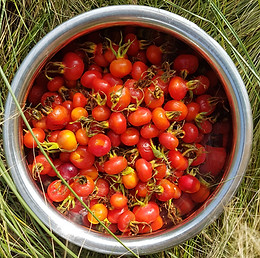
We love food.
We love good food.
And we love growing good food.
However, not everyone has easy access to spaces where they can grow their own food and enjoy the marvel of planting seeds that then turn into fruits and vegetables. So, that's one of the things we offer here.
At Creative Beings, there are many ways to access food, and the processes that go to make it:
-
join a Pottering With Plants guided conversational morning
-
sign-up for a Foraging & Preserving course
-
apply to tend the Food Forest as a WWOOFER
-
attend one of our courses where we serve lunches from the land
Scroll down to learn more about our food ...
Growing & preserving food




Some say that the UK food system is broken, being driven by large, overly-extractive companies rather than organisations that have a genuine interest in marrying up the needs of the land with human needs for sustenance.
We're far too small to make a difference at a national level. But we can make a difference locally, as discussed by E F Schumacher in 'Small Is Beautiful - A Study of Economics As If People Mattered'.
Depending on the season, we have a range of vegetables, fruit, salads and herbs growing in our garden, Food Forest and polytunnel. We follow permaculture principles e.g. using 'no dig' when we plant perennials into a top layer of mulch. The juxtaposition of different varieties encourages more of a foraging approach rather than heavy-cropping. So, different foods are grown side-by-side and one species may appear in several locations.
Seed-planting starts in Spring and continues throughout the year. The main harvest comes in September and we forage at other times. We like to experiment with any plant that can be eaten, including:
-
marching onions
-
turban squash
-
autumn olive
-
nectarine
-
rosa rugosa
-
tree kale (for year-round greens)
-
cranberries


Like many people, we are trying to reduce our carbon footprint, increasingly eating a vegetarian diet. However, we also enjoy a bit of locally-reared, organic, grassland-fed meat every now and then. From an environmental point of view, it's hard to know which meat is best to eat (e.g. see information from the Soil Association) but, certainly, it's better to cut down the amount of meat we eat.
We top up with what we do not have on site by buying from a collective called In My Back Yard, that connects local small suppliers and makes it easy to order a weekly shop. And there are some things we can only get from the larger well-known retailers. Even there, we prioritise local, organic and minimally-packaged goods.


Some highlights from our Foraging & Preserving courses



When it's time to harvest, we are faced with the delicious prospect of bucket-loads of blackcurrants, armfuls of apples, barrow-loads of beans, a mountain of squash and more. So, to enable us to enjoy these flavours on our courses and events throughout the year, we pickle, blanche, freeze, preserve, jam, salt, dehydrate, ferment and pasteurise.
Cleavers Spring tonic
Wild garlic salt

Pickled garlic buds




